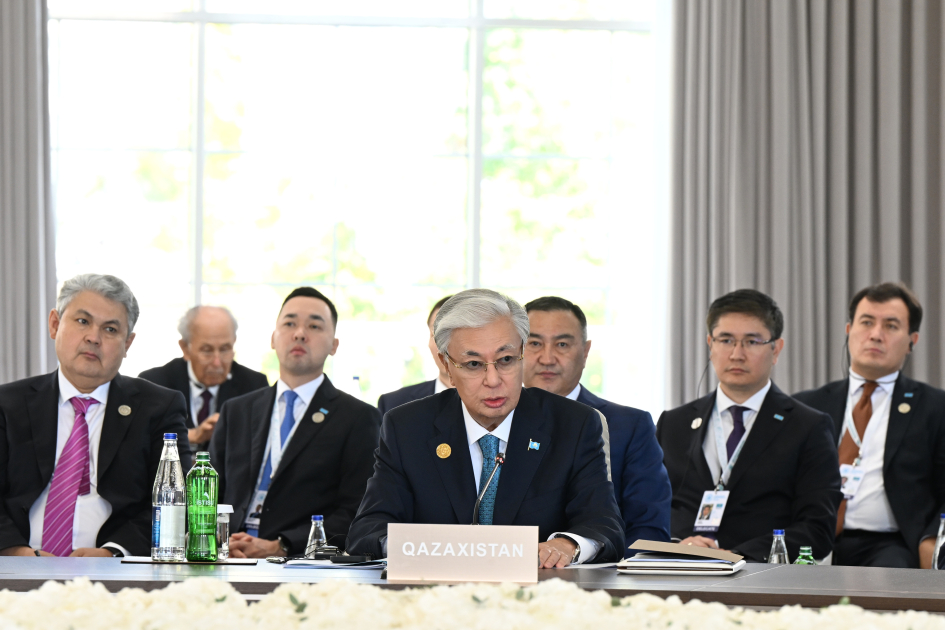By Alyona Pavlenko
Copyright trend

BAKU, Azerbaijan, October 8. During the 12th
Summit of the Organization of Turkic States (OTS), held on October
7, 2025, in Gabala, Azerbaijan, President of Kazakhstan
Kassym-Jomart Tokayev once again highlighted the Middle Corridor as
a strategic link in the Eurasian transport network. The
Trans-Caspian International Transport Route, running through China,
Kazakhstan, the Caspian Sea, Azerbaijan, Georgia, and Türkiye,
connecting East Asia with Europe, has already become a vital
lifeline for cargo flows between East and West and is slowly but
surely shaping up as a strong contender to traditional routes
through Russia.
Acting Secretary General of the International TITR Association,
Nurgul Zhakupova, told Kazakh media that in the first six months of
2025, cargo volume along the route reached 926,000 tons, a six
percent increase compared to the same period in 2024. Container
shipments showed particularly strong growth, with 40,200 TEUs
transported, up 93 percent year-on-year. Transit through Kazakhstan
increased by 65 percent, reaching 262,000 tons, primarily driven by
container cargoes from China. In May 2025, Tokayev announced plans
to double trans-Caspian container shipments over the next three
years. These figures paint a clear picture of the rising interest
in the Middle Corridor, showcasing its potential as a dependable
avenue for international trade.
The increase in cargo flows is accompanied by large-scale
infrastructure modernization in Kazakhstan. The launch of the
second Dostyk-Moynty railway line will increase the capacity of the
Trans-Kazakhstan corridor fivefold, while two more key lines are
under construction.
Moreover, during the 7th International Transport and Logistics
Business Forum New Silk Way in Almaty, railway company leaders from
Kazakhstan, Azerbaijan, and Georgia signed a joint action plan
aimed at ensuring uninterrupted transit train operations and
reducing transit times. The deal paves the way for lifting the
shackles along the Middle Corridor, covering everything from
infrastructure to operational and logistics matters, including
fast-tracked customs procedures.
On this account, at the OTS summit, Tokayev invited Turkic
states to actively participate in modernizing the infrastructure of
air hubs, railway stations, and seaports along the Middle Corridor.
Efforts are in full swing to put the pedal to the metal in
digitalizing the transport and transit sector with the help of
artificial intelligence technologies. The president threw his hat
in the ring with a proposal to set up a Digital Monitoring Center
within the OTS, bringing in top-notch experts. This move aims to
shine a light on transit transparency, streamline processes, and
cut costs, making the route a magnet for international investors.
These initiatives also align with Kazakhstan’s strategic goal of
becoming a fully digital state.
The growth of the Middle Corridor goes hand in hand with efforts
to bolster human capital through digitalization and AI initiatives.
Kazakhstan has already trained over 400,000 specialists and plans
to open a research university and establish a Digital Innovation
Center based at the International AI Center Alem.AI. This will
support joint projects, startups, and experience exchange among
Turkic states, strengthening the region’s technological potential
and integrating transport, industrial, and digital
infrastructure.
Frameworks are concurrently being developed to operationalize
significant trade and economic initiatives. One such initiative is
the Turkic Investment Fund, which plans to monitor investment
opportunities along the Middle Corridor. In 2025, a meeting of OTS
ministers of economy and trade is planned in Turkestan to compile a
list of projects for funding. Tokayev emphasized the need to fully
leverage the financial institution’s potential to stimulate
regional economic integration.
The strategic significance of the route is further enhanced
through integration with other corridors. At the Gabala summit,
President of Uzbekistan Shavkat Mirziyoyev noted that linking the
Middle Corridor with the China-Kyrgyzstan-Uzbekistan railway and
the prospective Trans-Afghan corridor will create a multi-sector
highway system that facilitates business development and reduces
transit costs. OTS Secretary General Kubanychbek Omuraliev
emphasized that the strategic importance of the Middle Corridor
will grow even further once the China–Kyrgyzstan–Uzbekistan railway
project becomes operational.
Kazakhstan is also putting its best foot forward in
strengthening international ties along the Middle Corridor. In July
2025, during Tokayev’s official visit to Türkiye, an agreement on
railway transport cooperation along the Middle Corridor was signed
between Kazakhstan Temir Zholy (KTZ) and Türkiye’s TCDD Taşımacılık
A.Ş. Negotiations are also underway on hydrocarbon shipments along
the route with international partners, including Chevron.
At the summit, Tokayev also supported the creation of a “Turkic
States +” format, aimed at expanding cooperation and strengthening
the international authority of the OTS. Today, OTS member states
include Azerbaijan, Kazakhstan, Kyrgyzstan, Türkiye, and
Uzbekistan, with Hungary and Turkmenistan as observers.
Thus, the Middle Corridor continues to strengthen its position
as a strategic transport route in Eurasia, largely due to the
proactive role of President Kassym-Jomart Tokayev. His support for
infrastructure modernization, transit digitalization, workforce
development, and international cooperation creates conditions for
increased route efficiency, higher cargo flows, and trade growth.
Joining forces with other transport corridors and getting OTS
member states on board with Tokayev’s initiatives paves the way for
a sturdy highway system that can cut transit costs and boost
economic and technological ties in the region.